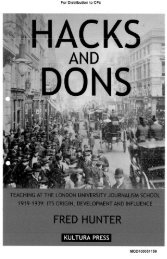The Edi ' - The Leveson Inquiry
The Edi ' - The Leveson Inquiry
The Edi ' - The Leveson Inquiry
You also want an ePaper? Increase the reach of your titles
YUMPU automatically turns print PDFs into web optimized ePapers that Google loves.
Hate likely complainants been given an adequate opportunity to<br />
respond?<br />
For Distribution to CPs<br />
Proving sufficient care: A complaint by the European Commission<br />
~a~m ~ M~il on Sund~,: H~orl 53. 2000~ was rejected because<br />
the PCC decided the paper had taken sufficient care to check the<br />
accuracy of a story suggesting an EC summit was to discuss a £30a-year<br />
levy on telephone Fines<br />
Was it significant? <strong>The</strong> spidt of the Code protects a substantially<br />
true story from failing due to a trifling error, <strong>The</strong> PCC’s<br />
commonsense test of significance is simple: How much does it really<br />
matter?. Getting a name wrong could be merely irritating -- or wholly<br />
fundamental. <strong>The</strong> context would be crucial. <strong>The</strong> PCC might need to<br />
decide if the alleges error, taken alone, was of consequence, or even<br />
if a series of relatively minor errors, taken together, were likely to<br />
mislead or distort.<br />
....<br />
Firet, the story was based on a report on an official EC webslte<br />
whch gave no ndication that it was out of date;second the paper<br />
had twice asked the EC press office to comment, but received no<br />
In 1998 m ~nt ;J <strong>The</strong> GuaMdi~n’ R~.#or~ 45 ~9} a man who had<br />
wdtten criticallysbout <strong>The</strong> Guardian,<br />
’<br />
complalncledt~tap~e~:di~aa<br />
’" ’ h d<br />
published in response was littered with ins curs los, g<br />
response; and third, it had made clear this was a proposal for<br />
~h:;hu:~h:hedh<br />
a<br />
.^._...,__ ____.^ ._ _ __+,...4,..,.~, ~.PGG decaea the news ,a ernadanen to -<br />
g<br />
cons deretion which had not been adopted <strong>The</strong>se checks showed " P P<br />
nvestigate s cr tic who had made serious allegations against it. In the<br />
that the oscar<br />
" "<br />
had taken sufficient care on a s<br />
P<br />
nts<br />
¯ . context of the piece all the points were minor ~ except rer * an errsr<br />
<strong>The</strong> case demonstrates that ad tots are not a ways respons b e<br />
over VAT repayment. That was s gnif cant, but had already been<br />
for potenbally mlsieadmg reports. <strong>The</strong>re can be factors over which ........<br />
corrected by the newspaper, ins compiamz was rejecrea.<br />
they can have no control and there can be occe<br />
s<br />
one when the error<br />
is caused by contributory negligence on the part of the complainant.<br />
Conversely a complaint against a Sunday tabloid was upheld Was it tree? If the point is significant, the next test Is whether it is<br />
because the paper failed to put details of an uncorroborated kiss- true. <strong>The</strong> PCC will expect from editors supporting evidence for e<br />
and-tell story to the subject of the piece prior to publication. <strong>The</strong> PCC story, wherever possible, demonstratmg that it wasn t maccurete,<br />
ruled ~V~rkishif v Sund~3y Spm~-t- ~,÷po*r 5& 2~0~ ,’~ that this<br />
misleading or distorted. However, the truth is not always easy to<br />
amounted to insufficient caie to establish the truth<br />
establish, especially if a newspaper or magazine is relying for its<br />
information on a single confidential source, which it has a duty to<br />
3rotect under the Code S~,~ C?aus~- 1A Com’~o~nu~ scmz::~:m.<br />
This requires publications to offer a suitable remedy if the story,<br />
mcludtng pictures, was significantly inaccurate, misleading or<br />
distorted. <strong>The</strong> burden of proof, as always in the PCC system, falls on<br />
the editors+/f they wish to claim the story was true, then they will<br />
need to demonstrate that there were no significant inaccuracies or<br />
distortions and that it was not m~stesemg. Even if the story was not<br />
entirely correct, the newspaper would Be exonerated if it could<br />
demonstrate that it had taken sufficient care to avoid inaccuracy, or<br />
that it had offered a suitable remedy<br />
<strong>The</strong> PCC has no powers of sue-peens, or of veritying<br />
unsupported ewoence and n rare cases it has preyed ~mpossible to<br />
decide whether a story was accurate or not, In such situations, the<br />
............................ whether it is reasonable for the<br />
complainant to be given an opportunity to reply.<br />
In 2002 Cabinet Minister Charles Clarke accused a newscaper<br />
of inventing a story that he ~ad ’told friends’ he regarded the Speaker<br />
of the House of Commons as a liability ~C[#s+¢x~ MP 7/~÷ Tm’~:s<br />
7~.7; ~. t ~+~;~t~.~5~ ~Vt~2 ’~’il’#
















